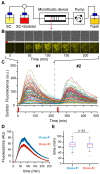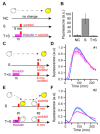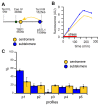Hyperosmotic Stress Response Memory is Modulated by Gene Positioning in Yeast
- PMID: 31200564
- PMCID: PMC6627694
- DOI: 10.3390/cells8060582
Hyperosmotic Stress Response Memory is Modulated by Gene Positioning in Yeast
Abstract
Cellular memory is a critical ability that allows microorganisms to adapt to potentially detrimental environmental fluctuations. In the unicellular eukaryote Saccharomyces cerevisiae, cellular memory can take the form of faster or slower responses within the cell population to repeated stresses. Using microfluidics and fluorescence time-lapse microscopy, we studied how yeast responds to short, pulsed hyperosmotic stresses at the single-cell level by analyzing the dynamic behavior of the stress-responsive STL1 promoter (pSTL1) fused to a fluorescent reporter. We established that pSTL1 exhibits variable successive activation patterns following two repeated short stresses. Despite this variability, most cells exhibited a memory of the first stress as decreased pSTL1 activity in response to the second stress. Notably, we showed that genomic location is important for the memory effect, since displacement of the promoter to a pericentromeric chromatin domain decreased the transcriptional strength of pSTL1 and led to a loss of memory. This study provides a quantitative description of a cellular memory that includes single-cell variability and highlights the contribution of chromatin structure to stress memory.
Keywords: cellular memory; chromosome organization; single cell; stress response; yeast.
Conflict of interest statement
The authors declare no conflict of interest.
Figures




Similar articles
-
Conservation of a stress response: human heat shock transcription factors functionally substitute for yeast HSF.EMBO J. 1997 Nov 3;16(21):6466-77. doi: 10.1093/emboj/16.21.6466. EMBO J. 1997. PMID: 9351828 Free PMC article.
-
Analysis of Saccharomyces cerevisiae genome for the distributions of stress-response elements potentially affecting gene expression by transcriptional interference.In Silico Biol. 2009;9(5-6):379-89. doi: 10.3233/ISB-2009-0412. In Silico Biol. 2009. PMID: 22430439
-
Contributions of low molecule number and chromosomal positioning to stochastic gene expression.Nat Genet. 2005 Sep;37(9):937-44. doi: 10.1038/ng1616. Epub 2005 Aug 7. Nat Genet. 2005. PMID: 16086016
-
Coregulation of starch degradation and dimorphism in the yeast Saccharomyces cerevisiae.Crit Rev Biochem Mol Biol. 1997;32(5):405-35. doi: 10.3109/10409239709082675. Crit Rev Biochem Mol Biol. 1997. PMID: 9383611 Review.
-
Reprogramming of nonfermentative metabolism by stress-responsive transcription factors in the yeast Saccharomyces cerevisiae.Curr Genet. 2017 Feb;63(1):1-7. doi: 10.1007/s00294-016-0609-z. Epub 2016 May 14. Curr Genet. 2017. PMID: 27180089 Review.
Cited by
-
Do microbes have a memory? History-dependent behavior in the adaptation to variable environments.Front Microbiol. 2022 Oct 10;13:1004488. doi: 10.3389/fmicb.2022.1004488. eCollection 2022. Front Microbiol. 2022. PMID: 36299722 Free PMC article. Review.
-
Yeast cell responses and survival during periodic osmotic stress are controlled by glucose availability.Elife. 2024 Apr 3;12:RP88750. doi: 10.7554/eLife.88750. Elife. 2024. PMID: 38568203 Free PMC article.
-
Protein acetylation regulates xylose metabolism during adaptation of Saccharomyces cerevisiae.Biotechnol Biofuels. 2021 Dec 17;14(1):241. doi: 10.1186/s13068-021-02090-x. Biotechnol Biofuels. 2021. PMID: 34920742 Free PMC article.
-
Cellular forgetting, desensitisation, stress and ageing in signalling networks. When do cells refuse to learn more?Cell Mol Life Sci. 2024 Feb 19;81(1):97. doi: 10.1007/s00018-024-05112-7. Cell Mol Life Sci. 2024. PMID: 38372750 Free PMC article. Review.
-
Microbial Adaptation to Enhance Stress Tolerance.Front Microbiol. 2022 Apr 27;13:888746. doi: 10.3389/fmicb.2022.888746. eCollection 2022. Front Microbiol. 2022. PMID: 35572687 Free PMC article. Review.
References
Publication types
MeSH terms
LinkOut - more resources
Full Text Sources
Molecular Biology Databases
Research Materials

